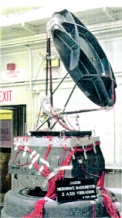JMR : Jason-1 Microwave Radiometer

The JMR acquires measurements via three separate frequency channels to determine the path delay of the altimeter's radar signal due to atmospheric water vapour.
Function
The JMR measures water vapour content in the atmosphere so that we can determine how it impacts radar signal propagation. Its measurements also can be used directly for studying other atmospheric phenomena, particularly rain.
Principle
The JMR is a passive receiver that collects radiation reflected by the oceans at frequencies of 18.7, 23.8 and 34 GHz.
Radiation measured by the radiometer depends on surface winds, ocean temperature, salinity, foam, absorption by water vapour and clouds, and various other factors. To determine atmospheric water vapour content accurately, we need to eliminate sea surface and cloud contributions from the signal received by the radiometer. This is why the JMR uses different frequencies, each of which is more sensitive than the others to one of these contributions. The main 23.8 GHz frequency is used to measure water vapour; the 34 GHz channel provides the correction for non-rainbearing clouds, and the 18.7 GHz channel is highly sensitive to wind-driven variations in the sea surface. By combining measurements acquired at each of these frequencies, we can extract the water vapour signal.
Further information :
- Instrument Description: Radiometer(s) (Nasa/JPL website).




